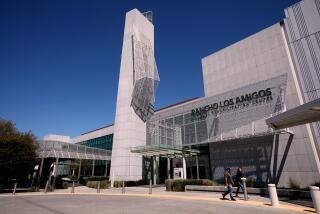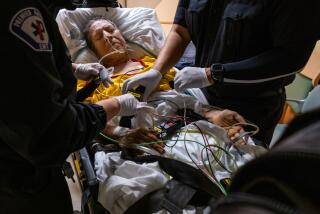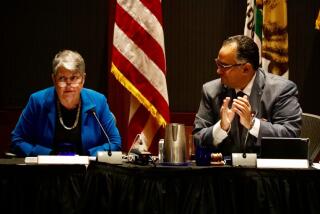Narrow Vote Keeps Trauma Care Unit at Palomar Alive
Doctors at Palomar Memorial Hospital voted narrowly Tuesday night to remain in the hospital’s trauma unit, but the beleaguered system faces yet another test as the result of the Escondido hospital board’s decision to let emergency room physicians opt out of trauma care.
Split almost down the middle, about 150 doctors voted in a closed, two-hour meeting Tuesday night to support the North County facility’s continued participation as one of the county’s six designated hospitals for treating victims of traumatic injuries, said Dr. David Cloyd, head of Palomar’s trauma unit.
But the margin of victory, which he would not quantify, was so narrow that he expects the divisive debate to continue.
Dissatisfaction High
“I think there continues to be some risk as to the long-term viability of the program,” Cloyd said of the only North County hospital now in the trauma system. “For the moment, the medical staff has stated that they want it to continue, and that they are willing to accept the current problems. But at the same time it reflects a very high level of dissatisfaction.”
Nearly half the doctors voting felt that the trauma unit hasn’t helped Palomar overall and represents “an unnecessary financial burden for the hospital,” Cloyd said.
Furthermore, acting on a doctors’ proposal, the hospital’s board, which has the final say on whether Palomar will remain in the trauma system, on Monday unanimously approved a change that will make it easier for doctors to avoid working in the trauma unit. That change could make it harder to find a full complement of physicians for the unit.
The change on July 1 will allow physicians to be on the call list for the emergency room without being on the call list for the trauma unit, said Robert J. Harenski, hospital administrator. Now, a doctor has to accept trauma duty to be on the emergency room list.
This opens a loophole through which some unhappy members of the trauma staff can be expected to jump.
“There are a number of people who are necessary to run the system who want to get out of it,” Cloyd said.
Palomar trauma doctors complain that, in addition to the high stress and difficult working conditions, they face substantial financial losses because of the large number of non-paying trauma patients the hospital sees.
Palomar expects 31% of its trauma patients this fiscal year to be non-paying, contrasted with 10% countywide during the last fiscal year. Palomar lost $2.1 million in 1986-87 because of this problem, and increased its trauma rates for paying patients last September to cut the deficit. However, the doctors were unable to similarly recoup their losses.
Harenski said that, if the policy cuts the number of surgeons, anesthesiologists, orthopedists and other specialists available for trauma care, “the hospital would fill those gaps and would work with the medical staff.”
Specialists Required
As a designated county trauma center, Palomar is required by county contract to have a certain number of specialists available at all times to care for trauma patients--the victims of car accidents, shootings and stabbings who would die if not quickly cared for.
“We’ll have to discuss with them what would happen if they discontinued having physician commitment to the program,” said Gail Cooper, director of emergency medical services for San Diego County. “Their staffing pattern is their responsibility.”
Cloyd noted that Palomar’s neurosurgeons now are on 24-hour trauma call every other day to meet the contractual staffing requirements. Thus, the loss of even one specialist in such a thinly staffed specialty could have a major impact.
General surgeons are on call roughly every six days and anesthesiologists about three times a month.
Concern About Resources
Among non-trauma doctors, opposition to Palomar’s continuing participation in the trauma system has centered on concern that it is draining hospital resources and inconveniencing other patients. It causes problems, for instance, with availability of operating rooms for non-emergency surgeries.
“A room is kept available 24 hours a day for potentially life-threatening trauma injuries, so that clearly has an impact on our ability to process a backlog of non-trauma cases,” said Dr. Lawrence G. Getz, a trauma surgeon. “Non-trauma cases end up being done at very late hours.”
Such problems led Palomar doctors to hold a similar meeting last spring, when they decided to hold off voting on the matter until this spring. The year since has been difficult, Cloyd said.
“It’s alienated one physican against another, split up relationships, really torn up the medical staff,” he said.
Although the staff remains split, there are no plans for another vote, Cloyd said with some relief, adding, “I certainly wouldn’t want to go through this anytime soon.”
San Diego County’s trauma system was established in August 1984 and is considered a national model for reducing the number of patients dying from traumatic injuries. The system is credited with cutting preventable trauma deaths from 30% to less than 1%.
In ambulances and helicopters, patients are routed past the nearest hospital to the geographically closest trauma center, where specialists are always available to provide state-of-the-art care.
Won Designation
Palomar won designation as the only trauma hospital in North County after a bitter battle with the county by Tri-City Medical Center in Oceanside, which also wanted the designation. The other five in the system are Children’s Hospital and Health Center, Mercy Hospital and Medical Center, Sharp Memorial Hospital, Scripps Memorial Hospital-La Jolla and UCSD Medical Center.
More to Read
Sign up for Essential California
The most important California stories and recommendations in your inbox every morning.
You may occasionally receive promotional content from the Los Angeles Times.










